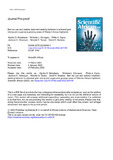| dc.contributor.author | Kipcho, D.Mukabane | |
| dc.contributor.author | Nicholas, L.Kitungulu | |
| dc.contributor.author | Philip, A.Ogutu | |
| dc.contributor.author | Jackson, K.Cheruiyot | |
| dc.contributor.author | Ndombi, S.Tavasi | |
| dc.contributor.author | David, H.Mulama | |
| dc.date.accessioned | 2022-03-21T11:33:10Z | |
| dc.date.available | 2022-03-21T11:33:10Z | |
| dc.date.issued | 2022-03-03 | |
| dc.identifier.uri | https://doi.org/10.1016/j.sciaf.2022.e01140 | |
| dc.identifier.uri | https://www.sciencedirect.com/science/article/pii/S2468227622000497#! | |
| dc.identifier.uri | http://ir-library.mmust.ac.ke:8080/xmlui/handle/123456789/2032 | |
| dc.description.abstract | Provision of the bed net in Sub-Saharan Africa has substantially resulted in the decrease in malaria incidences in the region. However, malaria still ravages these regions causing significant deaths. This situation has been attributed to socio-economic inequalities that reduce access to the net, failure to seek treatment, and poor antimalarial drug use. Information about these factors in malaria control in Western Kenya highlands is not clearly documented. This study sought to find out bed net availability and use, treatment-seeking, and antimalarial drug use behavior in two rural communities. The study was a qualitative-quantitative baseline cross-sectional survey carried out in two rural villages in Western Kenya highlands in November – December 2018. Focus group discussion, a semi-structured questionnaire, and in-depth interviews were conducted in 736 households to determine: socio-demographic characteristics; bed net availability and use; action taken when sick with malaria, and anti-malarial drug usage. Socio-demographic characteristics and the responses of the participants were expressed as percentages. Dependent and independent variables were cross-tabulated for calculation of OR and association was tested using Pearson Chi-square at 95% CI and a p ≤ 0.05 was considered significant. Ninety-three percent of the respondents had used the net the previous night, females (56.50%) constituted the majority of respondents, going to health facility (84.26%) was the preferred action taken when a person had malaria, Artemether Lumefantrine (90.19%), and a pain killer was the most cited drug, 22.96% of the responders reported to have failed to complete anti-malarial dose saying that they had recovered from the malaria bout and 9.80% reported to re-use the remaining part of the dosage. This was the first study in mining and sugarcane growing communities in Western Kenya Highlands that has shown that there was no association between socio-demographic parameters and bed net use, action taken when having malaria, and adherence to drug use. The two rural communities have the bed net and know its use. They have good knowledge of malaria and seek treatment whenever they saw malaria signs. The study also reported that the action the sick person took when they had a malaria bout, the drug they got from the health facility, or failure to complete an AL dosage regimen was not associated with socio-demographic characteristics of the responder. These findings raise the need for further qualitative studies in other settings to accept or deny that there was no association between socio-demographics and action taken when hit with malaria bout, the drug used, and failure to complete drug dosage. | en_US |
| dc.language.iso | en | en_US |
| dc.publisher | Scientific African | en_US |
| dc.subject | Bed, net, malaria, treatment, seeking, behavior, artisanal ,gold, mining, sugarcane, growing, areas | en_US |
| dc.title | Bed net use and malaria treatment-seeking behavior in artisanal gold mining and sugarcane growing areas of Western Kenya highlands | en_US |
| dc.type | Article | en_US |

